Psoriasis or scaly lichenIs a chronic disease affecting the skin and appendages: nails and hair. It is characterized by periods of worsening (relapse) and temporary well-being, when manifestations of the disease become less frequent. The disease is not contagious and the sick person is not dangerous to others. Since the appearance of psoriasis is not associated with microorganisms.
Psoriasis most commonly occurs between the ages of 15 and 45. People with fair skin are more prone to it. In developed countries, the number of patients with psoriasis is up to 2-4% of the population. Every 25th inhabitant of the earth on all continents suffers from it.
A large number of medical facilities are dealing with this problem. Therefore, psoriasis has been recognized as the most studied disease. However, the disease is still not fully understood. Officially, it is considered incurable and raises many questions.
Psoriasis is caused by the body's own immune cells. They emerge from the lower layers of the skin to the upper layers, causing inflammation, proliferation of epidermal cells, and the formation of small capillaries.
The manifestations of psoriasis on the skin are quite diverse. Most often, the disease causes the appearance of red spots - psoriatic plaques. They are dry to the touch, raised above the surface of the skin and covered with a white coating.
Types of Psoriasis
This disease is divided into two large groups: pustular psoriasis and non-pustular psoriasis.
Non-pustular psoriasis
- common (vulgar) or simple (plaque psoriasis, chronic stable psoriasis)
- erythrodermic psoriasis or erythrodermic psoriasis
Pustular psoriasis
- von Tsumbusch pustular psoriasis or systemic pustular psoriasis
- palmoplantar psoriasis (pustular psoriasis of the extremities, chronic persistent psoriatic psoriasis)
- annular pustular psoriasis
- palmoplantar psoriasis
- herpetiformis psoriatic impetigo
In addition, these types of psoriasis are distinguished.
- seborrheic psoriasis
- psoriasis of the superficial flexor muscles and skin folds
- Psoriasis of napkins
- drug-induced psoriasis
According to the severity, such forms of psoriasis are distinguished.
- Mild - less than 3% of skin is affected.
- On average - 3-10% of the skin is covered with psoriatic plaques.
- Severe - there is joint damage or more than 10% of the skin involved.
Causes of Psoriasis

To date, there is no clear answer to the question: "why does psoriasis appear? " Scientists have put forward several theories.
- Psoriasis is an autoimmune disease. It is based on a malfunction of the immune system. The immune cells of T-kills and T-helpers, which protect the body from viruses, bacteria and tumor cells, for some reason invade the upper layers of the skin. Here they produce inflammatory mediators - substances that "trigger" the inflammatory response. It leads to an increase in the division of skin cells and their multiplication (proliferation).
- Psoriasis is a disease caused by impaired growth, division and maturation of epithelial cells - keratinocytes. The result of such changes in the skin is the attack of immune cells by T lymphocytes and macrophages on diseased skin cells.
Factors that contribute to the development of psoriasis
Doctors have noted a number of factors that can cause the occurrence of the disease. Of course, psoriasis most often occurs if several of these conditions affect the body at the same time.
- Genetic predisposition.There is one version that the genes responsible for the immune system and the function of T lymphocytes are carriers of the disease. Therefore, parents with psoriasis are more likely to have their children develop the same symptoms.
- Thin dry skin. . . It is noted that people with such skin characteristics get sick more often than people with oily and hydrated skin. This may be due to the protective function of sebum and the structural features of the skin.
- External stimulants. . . A high proportion of patients are among those who are regularly exposed to alcohol solutions, solvents, household chemicals, cosmetics (skin lotion, hand cream).
- Excessive hygieneExcessive cleanliness also degrades the protective properties of the skin. Soaps, body washes and towels wash away the natural barrier and leave microscopic damage.
- Bad habits- Alcoholism, smoking and drugs are harmful to the skin. Her nutrition and blood supply are dwindling.
- HIV- AIDS patients are prone to psoriasis. Scientists cannot explain this phenomenon. The fact is that psoriasis is caused by an increase in the activity of lymphocytes, and with AIDS their number decreases.
- Medicine- taking certain drugs that can cause illness. Among them: beta-blockers, antidepressants, anticonvulsants and antimalarials, lithium carbonate.
- Infections (fungi and staphylococcus). . . Quite often, there are cases of psoriasis that appear immediately after a fungal infection or streptococcal diseases.
- Dynamic- a change of climate or even a season of the year, environmental degradation can be the cause of this disease.
- Stress- Strong emotional disturbance or physical stress (prolonged hypothermia, overheating, accidents) before the first symptoms of psoriasis appear.
- hurt- continuous effects on the skin: pressure, friction, scratches. Such frequent injuries can cause the first patches of psoriasis to appear here.
- Allergic condition- Allergic skin rashes and processes occurring in this case, in all layers of the skin, also increase the risk of the disease.
What are the symptoms and signs of psoriasis?
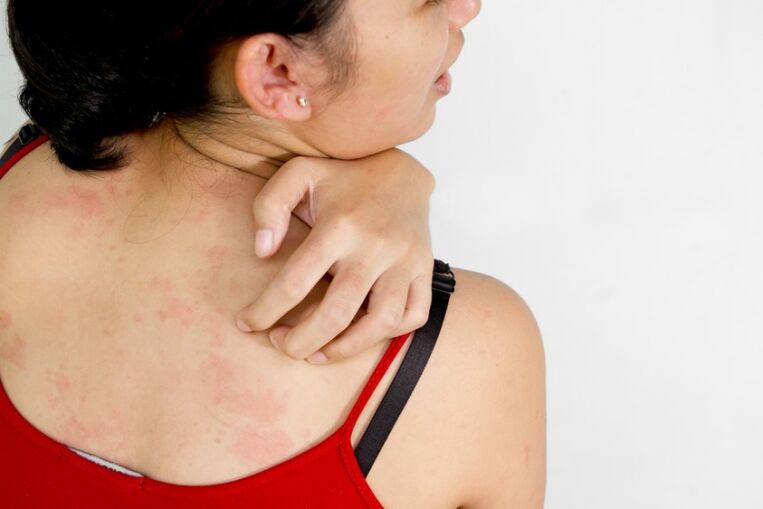
Psoriasis is a systemic disease that doesn't just affect the skin and nails. It affects the joints, tendons and spine, the immune, nervous, and endocrine systems.
But still, the main manifestations of the disease occur on the skin. The name scaly lichen conveys the symptoms of psoriasis quite accurately. The first manifestation is usually pink or bright red papules, precisely round in shape, covered with scales - psoriatic plaques. They are located symmetrically, mainly on the surface of the extender, lower back, and scalp. But they can affect any part of the skin and mucous membranes of the genitals. Their size ranges from a few millimeters, at an early stage, to 10 centimeters or more.
Depending on the characteristics of the rash, such astypes of psoriasis:
- Psoriasis - the size of the particles is smaller than the tip of a pin.
- Intestinal psoriasis - papules are teardrop-shaped and about the size of a lentil.
- Psoriasis - patches grow up to 3-5 mm and have rounded edges.
They also distinguish the forms of the rash, when its elements are in the form of rings, arcs and garlands, geographical maps with uneven edges.
The papules are covered with a scab that can be easily removed. It consists of keratinized cells of the epidermis. Psoriasis patches begin to become covered with scabs from the center, then the patches spread to the edges. Its loose and light appearance is due to the keratinized cells that are permeable to the air-filled spaces. A pink ring may form around the elements - this is an inflamed area, a growth zone of plaque. The skin around the elements of the rash is not changed.
Scalp psoriasisrepresent significantly raised psoriatic plaques on the surrounding skin. They are densely covered with dandruff-like scales. In this case, the hair remains unaffected. The rash can occur not only under the hair, but also on the smooth skin, on the neck and behind the ears. Such changes are explained by the active division of keratinocytes in the affected regions.
Psoriasis on the feet and palmscauses a strong thickening of the stratum corneum of the skin in these areas of the body. The skin becomes thick and rough. Cracks often pass through it. This is because cells divide 8 times faster than normal, but are not removed from the surface of the skin in time.
Psoriasis of the nailsvary in a wide range of symptoms. But most importantly are the two main types of damage to nail plates:
- In "thimble" style. Tiny pits are formed on the nails, similar to those of a needle.
- By nail fungus. Nail fungus-like lesions. Nails thicken, discolor, peel. Psoriatic papules are surrounded by a red rim visible through the nail plate. It looks like an oil slick through a nail.
The symptoms and signs of psoriasis vary depending on the stage of the disease, but alternate throughout the year. Therefore, most patients have "winter" disease, when exacerbations occur in the autumn-winter period. The condition of the disease is improved in the summer because ultraviolet rays in the sun have a therapeutic effect. But some patients have the "summer" pattern.
There are such stages of the course of psoriasis:
- progression - the appearance of new elements, active growth of existing plaques, areas of latent pink growth around them, severe peeling and itching.
- fixed - stops the growth of papules, no new rashes, good folds of the upper layer of skin around the psoriatic plaques.
- regressive - the absence of peeling, the disappearance of the patches and the appearance in their place in the pigmented areas, indicating a deterioration of the process.
What does a skin rash with psoriasis look like?
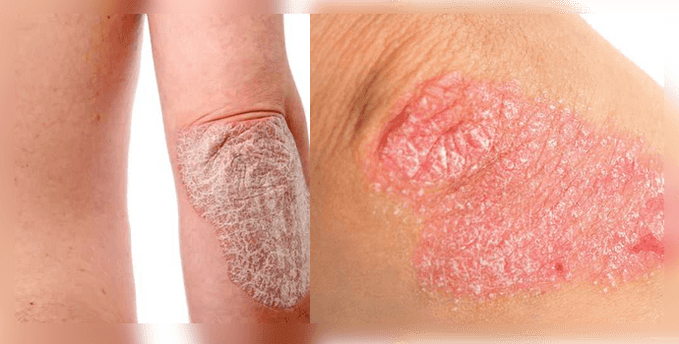
Every organism is individual and responds differently to disease. Therefore, the nature of the rash can be very diverse. This explains the variety of forms and types of psoriasis.
However, for most people, the symptoms of psoriasis are similar. These are red spots - psoriatic plaques, 1-3 mm above healthy skin. Their appearance is due to the fact that the cells of the surface layer of the skin - keratinocytes, which divide very actively, do not have time to mature and turn into full-fledged epithelial cells. As a result of this increased pathological development, some areas of the skin thicken. This is due to the fact that immune cells release chemicals that cause skin inflammation.
From above, the patches can be covered with a layer of gray, silver or yellowish flowers, which look like paraffin. Hence, they got the name - "paraffin lakes". These are keratinized epithelial cells, their elimination capacity is reduced and they accumulate on the surface of the diseased skin.
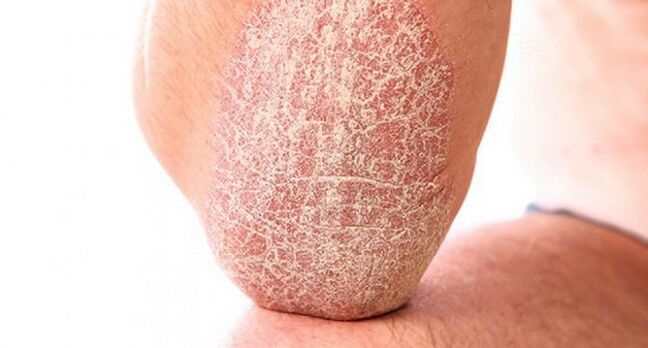
These nodules are flaky, hotter than the rest of the skin, and can grow to large sizes. Often the patient has a severe itching sensation in this area. This is due to the fact that, against the background of the inflammatory process, a variety of neuroreflex and allergic reactions occur.
Another type of factor is papules. These are small particles of a TB-like rash. Size is about 1mm. In the middle there is no compartment filled with content. They are usually located in the knee and elbow joints. They remain even during periods of remission.
In waves, the elements of the board gradually grow in width and merge with neighboring arrays. During the improvement (remission) period, the spots begin to lighten from the middle. They gradually take the form of a ring and can dissolve completely. After the patches, a trace remains on the body - skin pigmentation. It may be significantly lighter or darker than the surrounding skin. After a person is tanned, skin tone is usually evened out.
What do nail lesions look like in psoriasis?
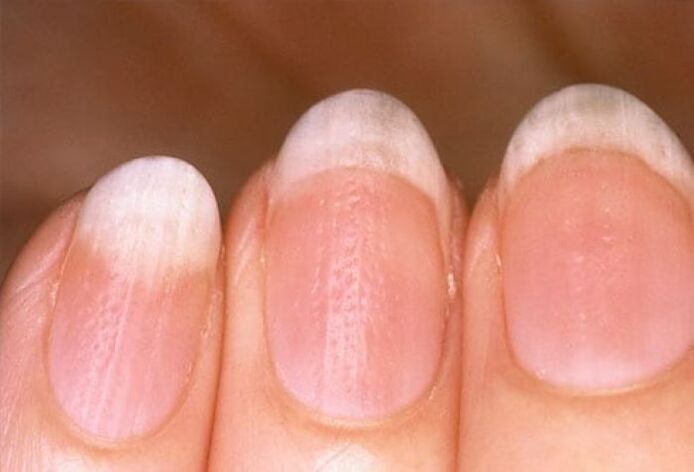
Psoriasis of the nails is similar to a fungal infection of the nails. For an accurate diagnosis, it is necessary to carry out laboratory analysis. Changes can affect just one nail or all at once and are variable. They occur in 10-15% of patients. Nail damage is often accompanied by joint pain from psoriasis. In this case, there may not be a rash on the skin.
Psoriasis of the nails has several stages:
- depressed point - nimble nails
- longitudinal recess
- horizontal compression in the middle of the nail, these first signs are related to damage to the nail root - nail matrix
- "Oily spots" are irregularly shaped pink spots that show through the nail - this is an accumulation of serous fluid under the nail
- nails become dull, opaque, yellow and thickened due to circulatory disorders
- The nail is shaped like a bird's claw, accompanied by pain. This is due to the fact that the process of arresting nerve endings.
Nail lesions begin at the margin and progress toward the base, covering the entire surface. Microcirculation disorder causes nails to clot and change color from yellow to green.
If you notice similar symptoms in yourself, don't self-diagnose. Similar changes can be caused by other reasons: fungus, trauma, and impaired blood supply.
Is psoriasis contagious?
This question is often asked by new diagnoses and patients' acquaintances. Scientists give a clear answer to it. Psoriasis is not contagious, the infected person is absolutely safe for others. This is because psoriasis is not caused by a virus or bacteria, but by active white blood cells. These immune cells, for unknown reasons, attack skin cells, causing skin inflammation. The result of this process is a rash and thickening of the skin in some places (plaques).
How is psoriasis treated?
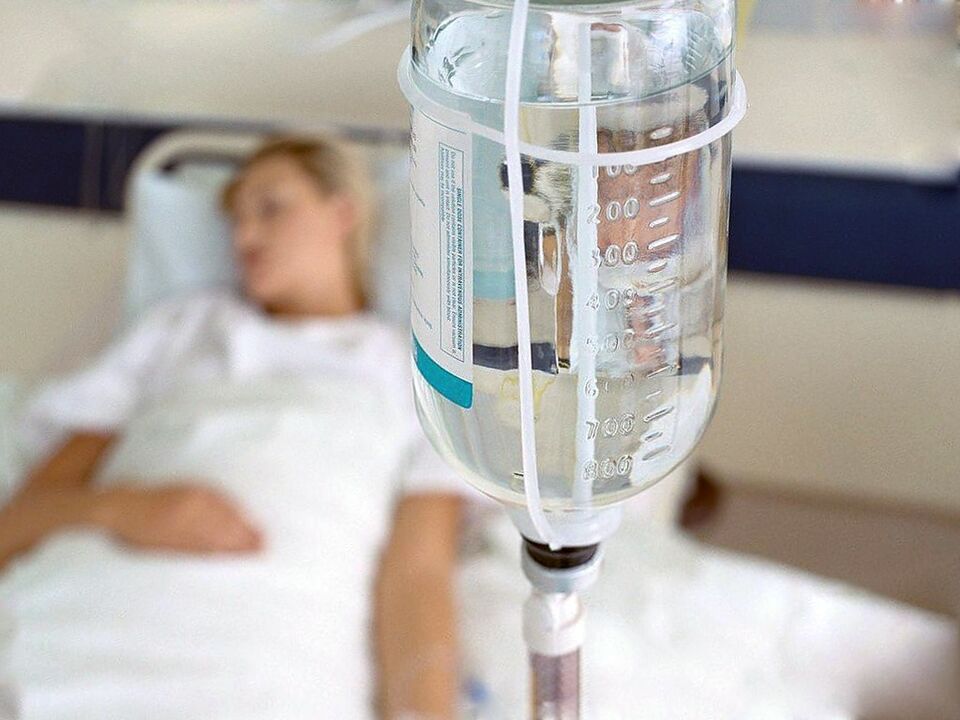
Treatment of psoriasis depends on the form and stage of the disease and how sensitive it is to the medication. Traditional medicine focuses on the use of drugs. Treatment is initiated with topical preparations acting on the affected skin. Therefore, they try to avoid the side effects that occur when taking drugs by mouth. More details on the use of topical remedies will be described below. Now let's focus on pills and capsules.
There is a technique where, first, the patient is given gentler medications with the fewest side effects. If they are ineffective, they are replaced by stronger ones, etc. v. Even in the case when the treatment is suitable for the patient, after a while it is changed. The fact is that the body gradually gets used to the drug and its effects gradually decrease.
Systemic medications are very effective. They are prescribed for moderate and severe stages of the disease. They help even patients for whom treatment by other means does not bring a positive result. However, they have significant disadvantages: they can cause serious side effects, and after removing these funds, the condition worsens again.
| Drug group | Dosage form and effects of the drug on the body |
| Retinoids - derivatives of vitamin A | Affects maturation of the superficial layer of the skin and eliminates disturbances in this process caused by psoriasis. Release form - capsules. Dosage according to the scheme, depending on the stage, 30-75 mg / day. Reduces the division rate of keratinocytes, promotes normal cell maturation and differentiation. Available in capsules. The daily dose is 25-50 mg. |
| Immunosuppressants - drugs that decrease the activity of the immune system | Reduces T-lymphocyte activity causing increased division of skin cells. Sterile solution in ampoules. The initial dose when injected intravenously is 3-5 mg / kg per day, for oral - 10-15 mg / kg per day. |
| Medicines to treat melanoma (cytostatic drugs) | Inhibits the overgrowth and reproduction of atypical cells of the epidermis. Available in tablets. Assign 2. 5-5. 0 mg orally, 2-3 times a day, 1 time per week. |
Physical therapy methods for psoriasis are very effective. They bring significant remission to patients, stop disease progression, and in some cases serve as a safe alternative to medication.
| Physiotherapy methods | Effects on the body |
| PUVA therapy or photochemotherapy | Combination of long-wave UV radiation and internal photosensitive material. The course is 20-30 sessions. This method is based on the fact that UV rays penetrate deep into the skin. Photosensitizers inhibit DNA synthesis of skin cells and their division rate. For treatment, special installations or cabins are used. |
| Selective spotlight (S. F. T) | Irradiate the skin with ultraviolet rays with a wavelength of 280-320 nm. The course is 15-35 procedures. A special booth is required for therapy. |
| Monochromatic UV treatment | Expose each focal point separately to a laser or lamp UV radiation source. It makes it possible to irradiate even hard-to-reach places without affecting healthy skin. It is prescribed in cases where less than 10% of the skin is affected. The course of treatment is 15-30 procedures. |
| Laser therapy | To treat rashes, people use laser radiation with different wavelengths. The laser promotes rapid resorption of psoriatic plaques, protecting from the appearance of scars at their site. The doctor determines the number of procedures individually for each patient. |
| Electrosleep | The procedure is performed on a device that relies on gently hitting the brain with weak electrical pulses. Duration 20-60 minutes. The number of procedures is 10-12. Electrosleep has a calming effect. As a result, the functioning of the nervous system normalizes, the plaques begin to disappear, and the period of health begins to accelerate. |
| Magnetic therapy | Magnetic therapy has a beneficial effect on the general condition. Itching and inflammation of the skin, swelling and joint pain are reduced, mental state is improved. The Betatron device is used for treatment. The duration of the procedure is 20 minutes. Number of each course 10-15. |
| Ultrasound therapy | It is used as an analgesic, antipruritic, and decongestant. Promotes scar healing. This procedure can be combined with the use of drugs (electrophoresis). Exposure time to one area is 15 minutes. To achieve a therapeutic effect, 7-14 treatment sessions are required. |
| Increased body temperature | Heat the fabric to a temperature of 40 degrees using a special pillow with a heat mixture. This effect on the body normalizes the activity of the immune system and it reduces the attack on the skin. The duration of the procedure is about 2 hours. Their number is determined by the doctor. |
| Treatment of bee venom | The substance is introduced into the body by electrophoresis or ultrasound equipment. Anti-inflammatory, absorbing, antipruritic effects are achieved. Metabolism is normalized. The minimum number of procedures is 10. |
It is very important for people with scaly lichen to follow the diet. Eating disorders can aggravate the condition. The menu needs to be rich in vitamins and at the same time simple. It will help the intestines and liver to rest, and will not cause allergies to the body.
| Products are allowed | Prohibited food |
| Vegetables (pumpkin, watermelon, beetroot, carrot, potato, radish) | Animal fat |
| Fruit (apricot, peach, apple), juice | Alcohol |
| Berries (except red berries: strawberries, raspberries, red currants) | Fatty meat (pork, duck) |
| Fresh herbs | Bacon |
| Lean meat (veal, beef, rabbit, turkey) no more than 200 g per day | Red fish |
| Cheese, cottage cheese, dairy products | Carbonated drinks and coffee |
| Nuts | Egg |
| Low-fat fish | Ice cream and milkshakes |
| Seaweed | Minimum amount of confectionery and sugar |
| Whole wheat bread | Butter and puff pastry |
To cleanse the body of toxins and metabolic products, it is necessary to fast twice a week. They recommend eating kefir, apples, vegetables.
What ointments are effective in the treatment of psoriasis?
The use of ointments for psoriasis is most effective compared with other external preparations. The ingredients of the ointment do not stay on the surface of the plaque, but soften the scales and go inside the skin.
There are a large number of ointments available to treat psoriasis. At the first stage, specifynon-hormonal ointment.
In case the treatment does not bring the expected effect, prescribe ithormonal ointment. . . Treatment begins with milder medications that have minimal side effects. If no improvement is achieved, a stronger ointment with glucocorticosteroids is prescribed.
| Ointment name | Drug action | Side Effects |
| Weak ointment | Inhibits the proliferation of white blood cells, prevents their migration into the skin, eliminates the feeling of tightness and itching. | Skin swelling, itching, redness. |
| Ointment just right | It has anti-inflammatory, anti-allergic, anti-edematous, anti-pruritic effects. Suitable for patients with exudative psoriasis, reducing bleeding. Apply a thin layer to restricted areas 2-3 times a day. Treatment lasts 10-14 days. | Acne, skin atrophy and tightness, burning, itching, hypopigmentation. |
| Strong Ointment | Topical anti-inflammatory, antipruritic and antiallergic agent. Reduce skin moisture. Apply to affected area 2-3 times a day for up to two weeks. Used during exacerbations. | Skin atrophy. |
| Very strong ointment | It has strong anti-itch and anti-allergic effect. Slows down cell division and keratinization. Apply 1-2 times a day, no more than two weeks for each course. | Acne, hair loss, skin atrophy. Do not use for widespread pustular and plaque psoriasis. |
Pharmaceutical companies produce many drugs in the form of ointments. The doctor will individually select each drug for the patient and, if necessary, change it to a stronger one.
Do not forget that there is no case of psoriasis, you should not skip your doctor's visits. After all, the disease can mask the early stages of skin cancer.
Choosing a psoriasis treatment regimen is a long process that involves a lot of trial and error. Don't despair if you don't find "your" medicine right away. Remember that many people achieve lasting improvement when the disease has not recurred for many years. You can do it too!

























